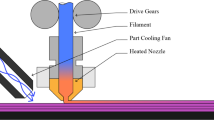Abstract
The goal of this research is to develop a costing framework and explore opportunities for fabricating components using additive manufacturing (AM) and machining approaches. The examples target plastic machining, and the fused deposition modeling AM process, but the general model structure is applicable for other AM processes as process knowledge is developed. The question “when is machining more cost-effective than AM” has not been comprehensively addressed. The purpose of this work is to develop a costing framework to provide insight on whether to use machining or AM. An estimation model which considers the process planning, setup, and fabrication time-cost elements is developed in a structured manner. This is challenging due to the machining process planning complexity, the decision-making, and the skill set required, especially for complex surface finish machining. This framework can be readily adapted to suit specific environments. The estimation time models are linked to a cost model, and comparisons are drawn, based on the form complexity and manufacturing quantity. An effective combination of AM and machining technologies could bring about a new hybrid manufacturing approach that meets the requirements of the next generation of production systems, especially for short-run production. A cost-benefit analysis is performed to illustrate solution approaches for designing additive, subtractive, or hybrid operation sets for a variety of components to highlight the merits of the presented approach. Exploring a larger solution space of processing options and their processing time and costs will allow designers to generate more cost-competitive solutions.
Similar content being viewed by others
References
Karunakaran SKP, Suryakumar S, Pushpa V, Akula S (2010) Low cost integration of additive and subtractive processes for hybrid layered manufacturing. Robot Comput Integr Manuf 26:490–499. https://doi.org/10.1016/j.rcim.2010.03.008
Onwubolu GC, Davim J, Oliveira C, Cardoso A (2007) Prediction of clad angle in laser cladding by powder using response surface methodology and scatter search. Opt Laser Technol 39:1130–1134. https://doi.org/10.1016/j.optlastec.2006.09.008
Eiliat H, Urbanic RJ (2018) Visualizing, analyzing, and managing voids in the material extrusion process, The Inter. J Adv Manuf Technol 96(9–12):4095–4109
Urbanic RJ, Burford C, Hedrick R (2018) Virtual quality assessment tools for material extrusion processes. Comput-Aided Des Applic 15:1–12. https://doi.org/10.1080/16864360.2017.1419640
Urbanic R, DiCecco L (2015) Development of adaptable light weighting methods for material extrusion processes. ASME. ASME International Mechanical Engineering Congress and Exposition, Volume 2A: Advanced Manufacturing ():V02AT02A003. https://doi.org/10.1115/IMECE2015-51174
Kaynak B, Spoerk M, Shirole A, Ziegler W, Sapkota J (2018) Polypropylene/cellulose composites for material extrusion additive manufacturing. Macromol Mater Eng 303:1800037. https://doi.org/10.1002/mame.201800037
Gonzalez-Gutierrez J, Cano S, Schuschnigg S, Kukla C, Sapkota J, Holzer C (2018) Additive manufacturing of metallic and ceramic components by the material extrusion of highly-filled polymers: a review and future perspectives. Materials 11:840
Ahn S-H, Montero M, Odell D, Roundy S, Wright P (2002) Anisotropic material properties of fused deposition modelling ABS. Rapid Prototyping Journal 8(4):248–257. https://doi.org/10.1108/13552540210441166
Radstok E (1999) Rapid tooling. Rapid Prototyp J 5(4):164–168
Lee CW, Chua CK, Chea CM, Tan LH, Feng C (2004) Rapid investment casting: direct and indirect approaches via fused deposition modelling. Int J Adv Manuf Tech 23(1):93–101. https://doi.org/10.1007/s00170-003-1694
Levy GN, Schindel R, Kruth JP (2003) Rapid manufacturing and rapid tooling with layer manufacturing technologies, state-of-the-art and future perspective. Manuf Technol J 52(2):589–609. https://doi.org/10.1016/S0007-8506(07)60206-6.
Saqib S, Urbanic RJ (2011) An experimental study to determine geometric and dimensional accuracy impact factors for fused deposition modelled parts. 4th International Conference on Changeable, Agile, Reconfigurable and Virtual Production. 293–298. https://doi.org/10.1007/978-3-642-23860-4_48
Rayegani F, Onwubolu G (2014) Fused deposition modelling (FDM) process parameter prediction and optimization using group method for data handling (GMDH) and differential evolution (DE). Int J Adv Manuf Technol 73(1):509–519
Steuben J, Iliopoulos A, Michopoulos J (2016) Implicit slicing for functionally tailored additive manufacturing. Comput Aided Des 77:107–119
Phatak AM, Pandey SS (2012) Optimum part orientation in rapid prototyping using genetic algorithm. J Manuf Syst 31:395–402. https://doi.org/10.1016/j.jmsy.2012.07.001
Gogate AS, Pande SS (2008) Intelligent layout planning for rapid prototyping. Int J Prod Res 46(20):5607–5631. https://doi.org/10.1080/00207540701277002
Ismail D, Rukiye E (2014) Experimental investigation of FDM process for improvement of mechanical properties and production cost. Rapid Prototyp J 20(3):228–235. https://doi.org/10.1108/RPJ-10-2012-0091
Volapato N, Foggiatto JA, Schwarz DC (2014) The influence of support base on FDM accuracy in Z. Rapid Prototyp J 20(3):182–191. https://doi.org/10.1108/RPJ-12-2012-0116
Singh H, Rayegani F, Onwubolu G. Cost optimization of FDM additive manufactured parts. ASME. ASME International Mechanical Engineering Congress and Exposition, Volume 2A: Advanced Manufacturing ():V02AT02A005. https://doi.org/10.1115/IMECE2014-36697
Eiliat H (2018) Development of optimal material extrusion additive manufacturing tool path parameters for minimizing void regions using contemporary tool path solutions, PhD Thesis, University of Windsor
Townsend V, Urbanic RJ (2012) Relating additive and subtractive processes in a teleological and modular approach. Rapid Prototyp J 18(4):324–338. https://doi.org/10.1108/13552541211231752
Hur J, Kunwoo L, Zhu-hu, Kim J (2002) Hybrid rapid prototyping system using machining and deposition. Comput Aided Des 34:741–754. https://doi.org/10.1016/S0010-4485(01)00203-2
AM Staff (2018) Thermwood offers large scale additive manufacturing (LSAM) line, AM additive manufacturing, Copyright © Gardner Business Media
Bentzen N, Laussen E (2018) Using recycled and bio-based plastics for additive manufacturing a case study on a low volume car component. Master’s thesis in product development, MASc. Thesis, Department of Industrial and Materials Science CHALMERS UNIVERSITY OF TECHNOLOGY Gothenburg
Urbanic RJ, Hedrick RW, Saqib S, Nazemi N (2018) Material bead deposition with 2 + 2 ½ multi-axis machining process planning strategies with virtual verification for extruded geometry. Int J Adv Manuf Technol 95:3167–3184. https://doi.org/10.1007/s00170-017-1376-9
Funding
This research is partially funded by the NSERC Discovery Grant research program.
Author information
Authors and Affiliations
Corresponding author
Additional information
Publisher’s note
Springer Nature remains neutral with regard to jurisdictional claims in published maps and institutional affiliations.
Rights and permissions
About this article
Cite this article
Urbanic, R.J., Saqib, S.M. A manufacturing cost analysis framework to evaluate machining and fused filament fabrication additive manufacturing approaches. Int J Adv Manuf Technol 102, 3091–3108 (2019). https://doi.org/10.1007/s00170-019-03394-x
Received:
Accepted:
Published:
Issue Date:
DOI: https://doi.org/10.1007/s00170-019-03394-x




